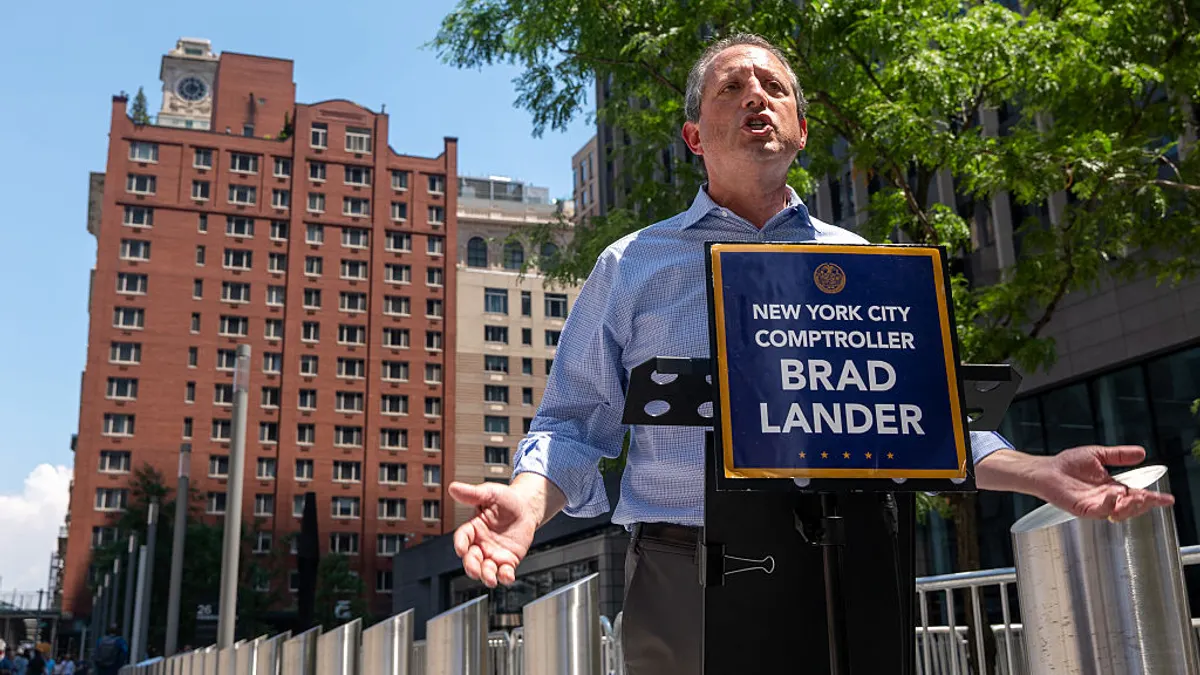Businesses looking to manage their ESG reporting, governance and goals are turning to consulting firms for help, according to Andrew Rizkallah, a senior manager at MorganFranklin Consulting.
A former supply chain engineer for Walmart, Rizkallah now leads the delivery of MorganFranklin’s ESG advisory service, he said in an interview with ESG Dive.
Between growing regulations — such as the Securities and Exchange Commission’s climate-risk disclosure rule, and others from the European Union and and California — and rising investor demand, Rizkallah said he has primarily seen three types of companies ask for MorganFranklin’s help. Regardless of where companies are in the journey, part of the job is explaining how they can benefit, he said.
“Change is hard, and there's a curve of adoption. Bridging that gap from the early adopters to the masses takes a little bit of, ‘What's in it for me?,’” Rizkallah said. “You have to prepare for that question, and you've got to be able to respond to it.”
Editor’s note: This interview has been edited for length and clarity.
What does your job look like day-to-day and what types of clients do you advise?
ANDREW RIZKALLAH: We’re a hands-on firm. We like to take clients where they want to go, [and] there's kind of different camps:
- There's companies that have been doing ESG reporting for years. And they have teams, and they're looking at making investments in technology to improve the processes for data collection and aggregation, calculation of greenhouse gas emissions and reporting. So in that case, we might help implement technology platforms and configure the system on behalf of the client.
- On the other side of the scale, there's companies that are kind of just getting started. Maybe ESG or sustainability is this hot potato that's being passed around between finance and legal and operations, and it's unclear who's going to own it in the future, but it is clear that someone needs to own it. In that case, we kind of become that holder of the hot potato and set up the tools, the program, the meeting cadence and the charter for the committees and all of that, in order to begin assessing climate-related risks and begin aggregating data.
- Then in the middle, there's like that army-of-one kind of company, where maybe there's like a senior director of sustainability or a VP that has been charged with doing everything [ESG or sustainability related] and does not have the resources to do all of that. In that case, we're just an extension of their hands.
For companies just starting, what does that governance structure look like?
Typically, there’s five things for sustainability governance:
- Completion of a materiality assessment: For the specific business with its specific stakeholders, and in its specific industry, of the universe of topics they could care about and could report on, what are those that matter? We'll guide them through that materiality assessment — or double materiality assessment [which identifies topics that are material to both investors and how the company impacts the environment and broader stakeholders] now is becoming the standard.
- Standardize the sustainability reporting structure: [Look at the] roles, responsibilities and accountability for the different groups that are going to ultimately bring items to the board.
- Connect aspects of enterprise risk management: We dig into if a company has an enterprise risk management function and do what we can to connect those. [For small-cap companies without well defined ERM policies] we try to build something specific to the material topics that they have.
- Building internal controls: Especially now that the rigor for investors is coming from the SEC and others trying to define and actually map the processes internally to gather data for things like scope 3 emissions … Just documenting those processes, honestly, is another step that a lot of companies haven't taken yet. Now internal audit teams are starting to pay attention, because they know this is going to go external, and there's going to be scrutiny.
- Strategic planning: Getting to the point where the business has growth objectives or there's new markets they want to enter, or there's new products on the horizon, and connecting those things — those strategic imperatives — to sustainability and looking at potential opportunities, especially with climate change, to tie those products and those services or those markets together.
You said double materiality is becoming the standard for materiality assessments. Is that a function of who you're working with and where they're located or an acknowledgment that this info could be asked for down the line?
My positioning to clients has been, if you’ve never done a materiality assessment, why only do single materiality? You want to do something that you're going to be able to look back on for the next two to three years, at least. The business can change in two to three years, and you may find yourself operating outside the U.S.
So while the SEC has focused on single materiality from an investor point of view, I encourage clients not to limit [themselves] to only the investor view. So I'm positioning them [with the idea that], going forward, the only materiality assessment you should be doing should be a double materiality assessment.
Has your advice to companies changed with the finalization and the litigation over the SEC’s climate disclosures?
Honestly, no. The litigation has delayed things, but most companies have known this was on the horizon for years now.
The final release was a catalyst for a lot of action and a lot of conversations with clients, but nobody's waiting to get their house in order because of this Court of Appeals situation. Because it's functionally inevitable that this reporting is going to have to happen, whether it’s to the SEC or to California, or to any other number of states that are now pursuing their own legislation.
That's the reality and that's the compliance side, let alone the diligence request from private equity or potential buyers, and then the customer requests. The rock or the snow ball has been rolling downhill for some time now, and now it's like avalanche time.
For companies with more reporting experience, what were some lessons learned?
One of the big ones [was around] setting targets and goals. There was a group of companies that got out ahead and set really ambitious [emissions] targets. And maybe those targets encompass scope 1, [scope] 2 and [scope 3]. [It was an] amazing level of ambition, [but] exceedingly difficult to grasp all of the things that go into scope 3 emissions.
I'm really encouraging clients to focus on scope 1 and scope 2, your direct boundaries. Set a target that is realistic, ideally aligned with a [pathway to limit additional temperature rises to] two degrees Celsius or 1.5 degrees Celsius, but something that you could achieve, especially now that there's going to be scrutiny.
I think there's some companies that maybe wish they could go back and change those targets they set a few years back, because they were so ambitious.
How are those leading companies expanding their sustainability and ESG practices?
More and more clients are considering specialized software for greenhouse gas accounting. It's become a lot more palatable now that there's compliance requirements and future assurance requirements. When you’re first getting started, trying to do everything in Excel is the gold standard of business. I think we’re moving beyond that, which is good.
A lot of clients are utilizing specialized software for these calculations, and, further down the maturity curve, those same customers are looking at integrations directly with their other business platforms.
This will be the kind of thing that companies could choose to almost completely outsource if they're just now getting started. But those that have invested in the internal teams will better be able to connect between their business strategy for growth and the specific levers that they want to pull for decarbonization.
How should the army-of-one work to get additional resources and buy-in?
Those people are really superheroes. They're extremely capable. They're typically balancing the internal reporting requirements … any number of client or customer requests. … There’s a lot of ad hoc reporting that happens.
Those people are looking at ways to connect their work to revenue, because that's how you grow your team and that's how you grow the business, and that's how you demonstrate that it's important to the business.
One message for companies in each bucket?
For companies just getting started: It's not too late. There is a little bit of that fear out there, and the key is just going to be to gather the right people together to solve it.
For the army-of-one: Keep going, and if only to be encouraging. Those people are swamped, but they also are highly capable, and I think they're going to come out on the other end with very marketable skills.
Early adopters and reporters: Maybe this is altruistic, but share what you know with your suppliers and vendors and the groups that are behind you, because there is a lot to do still, and we are all in this together.


















